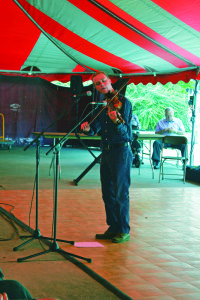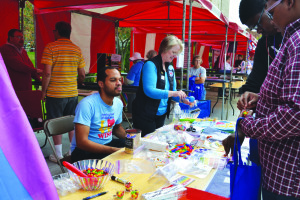Last Saturday, in Springfield’s City Hall Plaza – among off-blue fountains and a few statues of old, dead white guys – the  annual Culture Fest caused a plethora of colored tents to go up, selling a variety food and wares, and providing information on many different cultures in the Springfield community.
annual Culture Fest caused a plethora of colored tents to go up, selling a variety food and wares, and providing information on many different cultures in the Springfield community.
The festival has been a staple for the last 18 years, starting back in 1997 as a way to bring “people together for dialogue on race and ethnic issues,” according to the city of Springfield’s website.
Some of the informational booths have been there since almost the beginning. The Sikhs of America had a large booth with signs full of information right in the middle of the fair. This was their seventeenth year holding the booth. The parishioners of the world’s fifth-largest religion were distributing informational pamphlets and had people explaining their religious practices.
 The Miami Valley Islamic Association was there giving out pamphlets and free copies of the Qu’ran, encouraging people to read it themselves to find out more about Islam. A recent Wittenberg alumnus, Sana Ahmed, ’15, was working at the booth, offering to write people’s names in Arabic for them. Although they didn’t have a booth last year, Ahmed said they’ve be doing it as long as she can remember.
The Miami Valley Islamic Association was there giving out pamphlets and free copies of the Qu’ran, encouraging people to read it themselves to find out more about Islam. A recent Wittenberg alumnus, Sana Ahmed, ’15, was working at the booth, offering to write people’s names in Arabic for them. Although they didn’t have a booth last year, Ahmed said they’ve be doing it as long as she can remember.
Other Wittenberg alumni were working booths as well. Karlos Marshall, ’13, was working a booth for the non-profit he started with Moses Mbeseha, ’13, with Donna Hill, ’17, also helping out at the booth. The organization, The Conscious Connect, wants to get a diverse selection of books into barbershops and salons to encourage people to read during the down time and build reading comprehension.
The Heritage Center of Clark County and The Gammon House were there giving out information on Springfield’s own history. The Heritage Center was giving lessons on America’s oldest folk instrument, the dulcimer. It’s a three-stringed instrument of Germanic origin that comes in a variety of shapes.
There were also two stages for various performances throughout the day. On the stage, there was everything from a sign language choir to a group of people painted silver, dancing the techno and hip-hop music to a group of Indian Dancers. In the tent, there were performances ranging from hula dances and Irish Step dances to Wittenberg’s Imani Choir. A traveling mariachi band, an accordion player and a reggae band moved around the festival.
A large selection of food from all over the world  was being sold from a line of food trucks. You could buy croquettes – balls of food mashed together then deep-fried – wash them down with an Indian Mango Lassi – a sort of smoothie-like drink – and get a bowl of ramen for dinner. All of this while being tempted by pork chop sandwiches, gyros and Guatemalan tapas.
was being sold from a line of food trucks. You could buy croquettes – balls of food mashed together then deep-fried – wash them down with an Indian Mango Lassi – a sort of smoothie-like drink – and get a bowl of ramen for dinner. All of this while being tempted by pork chop sandwiches, gyros and Guatemalan tapas.
“The food booths are really diverse; the other stuff, not so much,” Zakkiyat Muhammed, ’17, said about the festival. Other students didn’t have this complaint.
“I like how there’s a lot of different cultures, and you can experience them all at the same time,” said Kethry Warren, ’18, about the fair.







